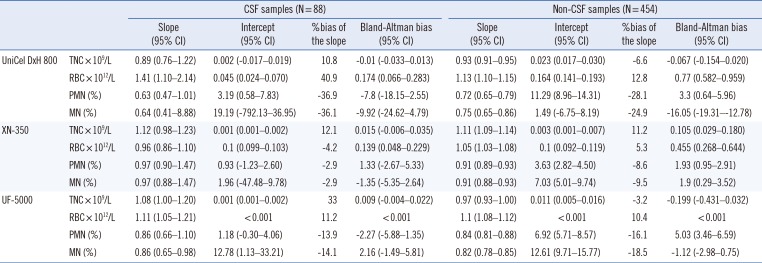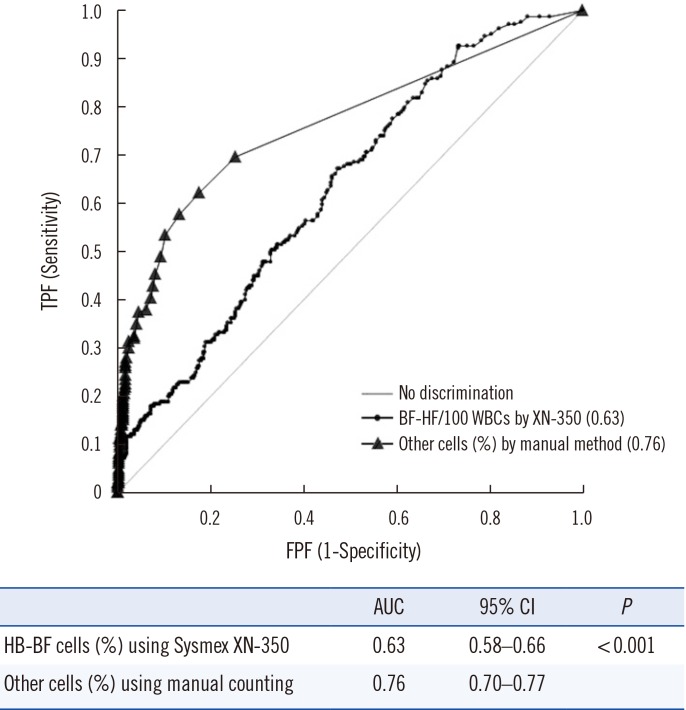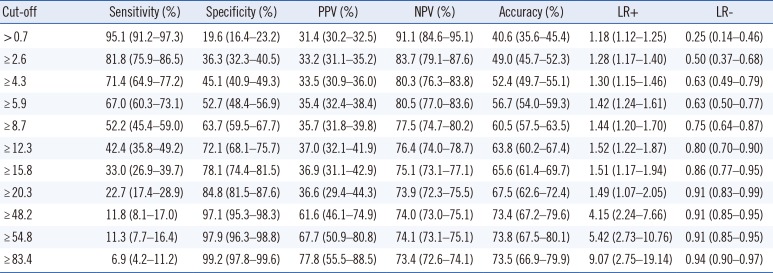1. Sandhaus LM. Body fluid cell counts by automated methods. Clin Lab Med. 2015; 35:93–103. PMID:
25676374.
2. Fleming C, Russcher H, Lindemans J, de Jonge R. Clinical relevance and contemporary methods for counting blood cells in body fluids suspected of inflammatory disease. Clin Chem Lab Med. 2015; 53:1689–1706. PMID:
25879321.
3. Yang D, Zhou Y, Chen B. Performance evaluation and result comparison of the automated hematology analyzers Abbott CD 3700, Sysmex XE 2100 and Coulter LH 750 for cell counts in serous fluids. Clin Chim Acta. 2013; 419:113–118. PMID:
23415694.
4. CLSI. Body fluid analysis for cellular composition; Approved guideline. CLSI H56-A. Wayne, PA: Clinical and Laboratory Standards Institute;2006.
5. Cho YU, You E, Jang S, Park CJ. Validation of reflex testing rules and establishment of a new workflow for body fluid cell analysis using a Sysmex XN-550 automatic hematology analyzer. Int J Lab Hematol. 2018; 40:258–267. PMID:
29314650.
6. Fleming C, Brouwer R, van Alphen A, Lindemans J, de Jonge R. UF-1000i: validation of the body fluid mode for counting cells in body fluids. Clin Chem Lab Med. 2014; 52:1781–1790. PMID:
24964259.
7. Nanos NE, Delanghe JR. Evaluation of Sysmex UF-1000i for use in cerebrospinal fluid analysis. Clin Chim Acta. 2008; 392:30–33. PMID:
18348868.
8. Cho YU, Chi HS, Park SH, Jang S, Kim YJ, Park CJ. Body fluid cellular analysis using the Sysmex XN-2000 automatic hematology analyzer: focusing on malignant samples. Int J Lab Hematol. 2015; 37:346–356. PMID:
25212101.
9. Bourner G, De la Salle B, George T, Tabe Y, Baum H, Culp N, et al. ICSH guidelines for the verification and performance of automated cell counters for body fluids. Int J Lab Hematol. 2014; 36:598–612. PMID:
24628711.
10. Sandhaus LM, Dillman CA, Hinkle WP, MacKenzie JM, Hong G. A new automated technology for cerebrospinal fluid cell counts: comparison of accuracy and clinical impact of GloCyte, Sysmex XN, and manual methods. Am J Clin Pathol. 2017; 147:507–514. PMID:
28419185.
11. Fleming C, Russcher H, Brouwer R, Lindemans J, de Jonge R. Evaluation of Sysmex XN-1000 high-sensitive analysis (hsA) research mode for counting and differentiating cells in cerebrospinal fluid. Am J Clin Pathol. 2016; 145:299–307. PMID:
27124911.
12. Danise P, Maconi M, Rovetti A, Avino D, Di Palma A, Gerardo Pirofalo M, et al. Cell counting of body fluids: comparison between three automated haematology analysers and the manual microscope method. Int J Lab Hematol. 2013; 35:608–613. PMID:
23647736.
13. Lehto TM, Leskinen P, Hedberg P, Vaskivuo TE. Evaluation of the Sysmex XT-4000i for the automated body fluid analysis. Int J Lab Hematol. 2014; 36:114–123.
14. Fleming C, Brouwer R, Lindemans J, de Jonge R. Validation of the body fluid module on the new Sysmex XN-1000 for counting blood cells in cerebrospinal fluid and other body fluids. Clin Chem Lab Med. 2012; 50:1791–1798. PMID:
23089709.
15. Labaere D, Boeckx N, Geerts I, Moens M, Van den Driessche M. Detection of malignant cells in serous body fluids by counting high-fluorescent cells on the Sysmex XN-2000 hematology analyzer. Int J Lab Hematol. 2015; 37:715–722. PMID:
26074270.
16. Beckman Coulter Inc. UniCel DxH 800. Coulter cellular analysis system instructions cellular analysis system instructions for use: use: PN B26647AE. Brea, CA: Beckman Coulter, Inc;2017. p. 127.
17. Previtali G, Ravasio R, Seghezzi M, Buoro S, Alessio MG. Performance evaluation of the new fully automated urine particle analyser UF-5000 compared to the reference method of the Fuchs-Rosenthal chamber. Clin Chim Acta. 2017; 472:123–130. PMID:
28760666.
18. Seghezzi M, Manenti B, Previtali G, Alessio MG, Dominoni P, Buoro S. Preliminary evaluation of UF-5000 Body Fluid Mode for automated cerebrospinal fluid cell counting. Clin Chim Acta. 2017; 473:133–138. PMID:
28843601.
19. Buoro S, Apassiti Esposito S, Alessio M, Crippa A, Ottomano C, Lippi G. Automated cerebrospinal fluid cell counts using cerebrospinal fluid cell counts using the new body fluid mode of Sysmex UF-1000i. J Clin Lab Anal. 2016; 30:381–391. PMID:
26302990.
20. CLSI. User verification of performance for precision and trueness approved guideline. 2nd ed. CLSI 15-A2. Wayne. PA: Clinical and Laboratory Standards Institute;2006.
21. CLSI. Evaluation of the linearity of quantitative measurement procedures: a statistical approach; approved guideline. CLSI approach approved guideline. CLSI EP06-A. Wayne, PA: Clinical and Laboratory Standards Institute;2003.
22. CLSI. Evaluation of detection capability for clinical laboratory measurement procedures; approved guideline. 2nd ed. CLSI measurement procedures approved guideline. CLSI 17-A2. Wayne. PA: Clinical and Laboratory Standards Institute;2012.
24. CLSI. Method comparison and bias estimation using patient samples; approved guideline. 2nd ed. (interim revision). CLSI 09-A2-IR. Wayne, PA: Clinical and Laboratory Standards Institute;2010.
25. Buoro S, Appassiti Esposito S, Vavassori M, Mecca T, Ottomano C, Dominoni P, et al. Reflex testing rules for cell count and differentiation of nucleated elements in pleural and ascitic fluids on Sysmex XE-5000. J Lab Autom. 2016; 21:297–304. PMID:
26149816.










 PDF
PDF ePub
ePub Citation
Citation Print
Print



 XML Download
XML Download